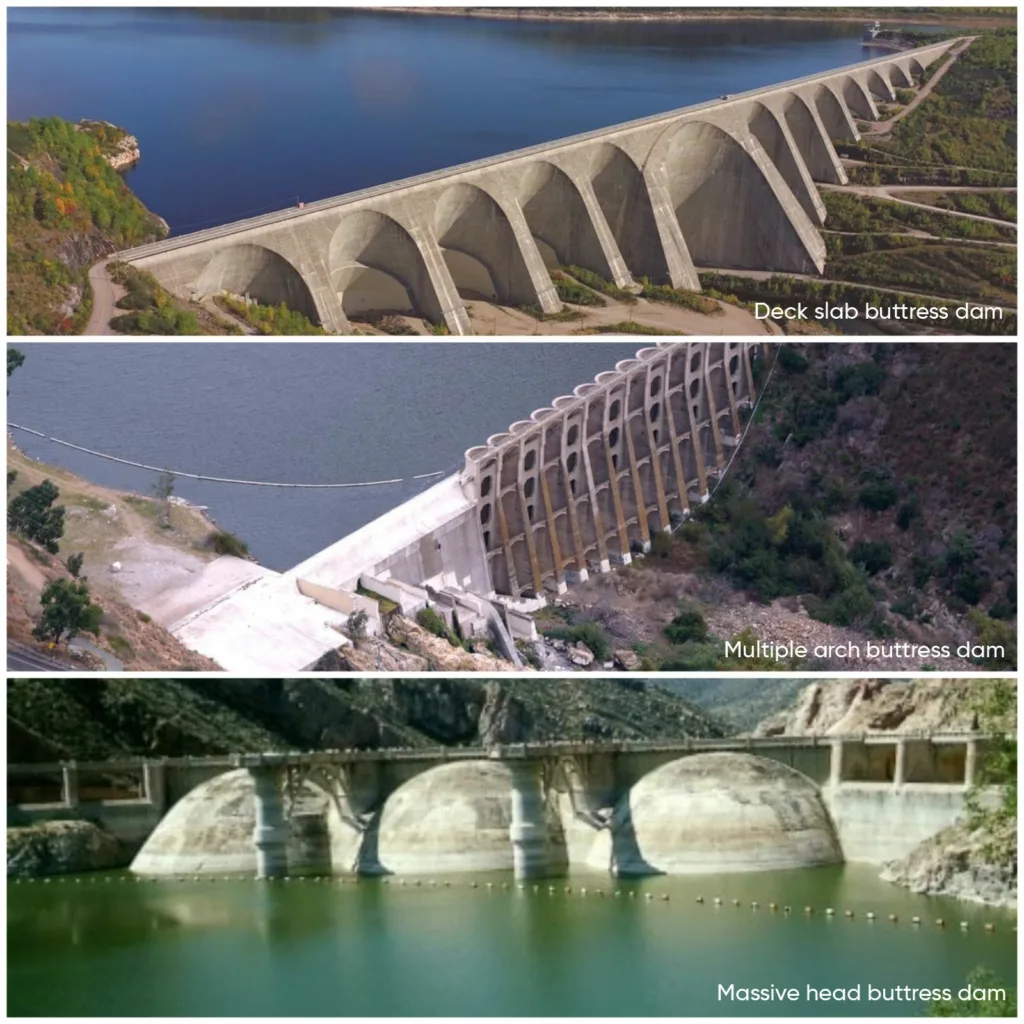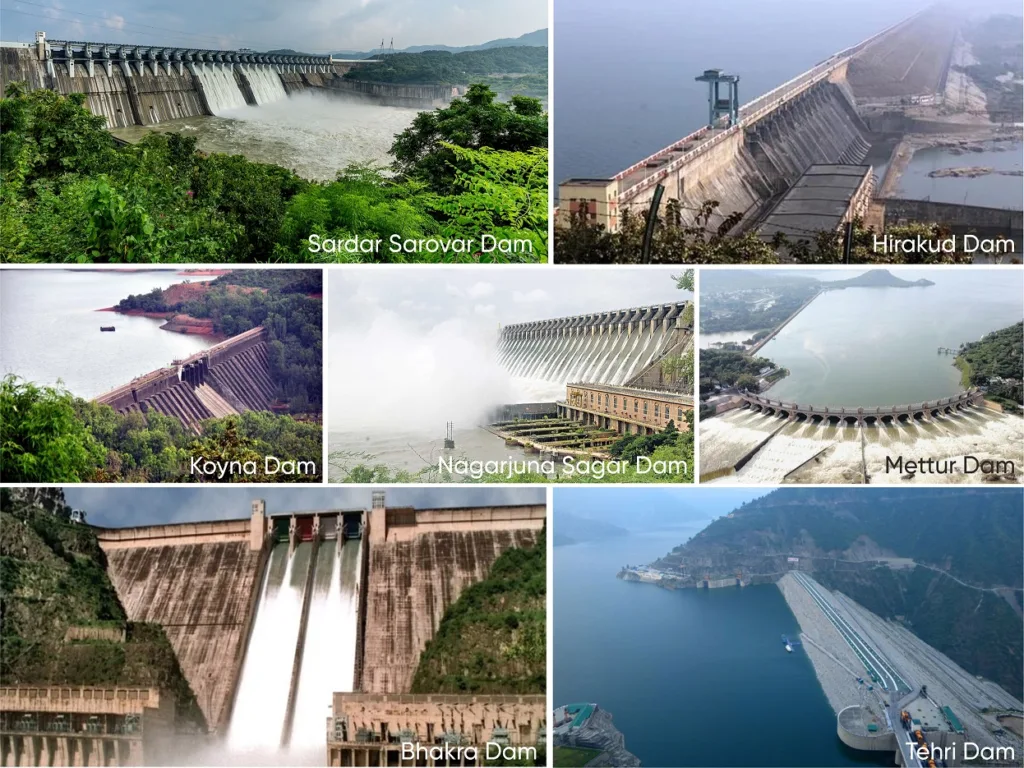Buttress are? Buttress is nothing but a solid wall which are constructed parallel with equal intervals at specific thickness for the water inflow.
In this article, we will discuss the function, different types, and benefits of buttress dams, often known as hollow dams.
Requirements of Buttress dam
The buttress dam requires less concrete than gravity dams. This is because the presence of buttresses allows for a reduction in the amount of material needed. Most important factor is they are built on a solid foundation of bedrock. The weight of the dam is used to hold a large quantity of water.
Purpose of the buttress dams;
Buttress dams serve several purposes as discussed below
1. Water Storage: Buttress dams provide the ability to store large volumes of water in reservoirs. This stored water can be used for various purposes such as irrigation, domestic water supply, industrial use, and hydropower generation. Buttress dams allow for the controlled release of water, ensuring a consistent and reliable water supply for different sectors.
2. Flood Control: Buttress dams help in mitigating the impact of flooding by regulating the flow of water in rivers and streams. During periods of heavy rainfall or snowmelt, the dam can store excess water and release it gradually, reducing the peak flow downstream.
3. Hydropower Generation: Buttress dams are often used for hydropower generation. The stored water in the reservoir is released through turbines, generating electricity. Buttress dams provide a reliable and renewable source of energy, contributing to sustainable power generation and reducing dependence on fossil fuels.
4. Water Supply: Buttress dams serve as a vital source of freshwater supply for human consumption. The stored water can be treated and distributed for domestic use, meeting the water needs of communities and urban areas.
5. Drought Mitigation: During periods of drought, buttress dams can provide a reliable water supply. The stored water can be released strategically to support water availability for essential needs, agriculture, and ecosystems during dry spells.
Types of buttress dams
1. Deck Slab Buttress Dam (also known as Ambursen type): In this type, a reinforced concrete slab is supported by a series of buttresses. The deck slab is inclined at an angle of 40 to 55 degrees with the horizontal. To provide a wider base, the upstream end of the buttress is often widened using haunch or corbel. The deck slab can be of three types: fixed, free, or cantilever. The advantage of this type is that if one slab gets damaged, it does not affect the other slabs.
2. Multiple Arch Buttress Dam: This type features a series of reinforced-concrete arches supported by buttresses. The upstream face of the dam is inclined at 45 degrees. Multiple arch buttress dams are more durable and flexible than other types. They can be constructed as a singular stiffened wall or a double hollow one. However, the dependency of the buttresses on each other is a disadvantage, as a problem with one buttress affects the efficiency of the entire dam. This type is suitable for larger heights, preferably above 50 meters.
3. Multiple Dome Buttress Dam: In this type, reinforced-concrete domes support the sloping membrane or deck, instead of arches. Using domes helps reduce the number of buttresses required, saving material and cost. The domes can be spaced farther apart compared to arches. Most other characteristics are similar to a multiple arch dam.
4. Multiple Octagonal Buttress Dam: This dam features octagonal-shaped buttresses arranged in a row along the length of the dam. It is commonly used in areas with moderate to high water pressures. Applications include water storage, flood control, and irrigation.
5. Massive Head Buttress Dam: This type does not have a separate water-retaining member. Instead, the water-retaining member is formed by enlarging the upstream end of the buttress. The dam is constructed with a series of buttresses and massive heads placed side by side. The construction is relatively easy due to the use of concrete mass and minimal reinforcement. The weight of the concrete makes it resistant to sliding. Copper strips are used to strengthen the extensions of the buttress heads.
6. Columnar Buttress Dam: In this type, columns support the flat deck slab of the dam. The columns are inclined to better support the deck. This is an altered version of the deck slab buttress dam, requiring a durable base and skilled personnel for construction. It is not as popular as other types of buttress dams.
7. Double Curvature Arch Buttress Dam: Also known as a curved buttress dam, this type features curved upstream and downstream faces. It is often used in locations with deep narrow gorges. Applications include water storage, flood control, and hydropower generation.

Advantages of buttress dams
1. Suitable for Flimsy Foundations: Buttress dams can be constructed on foundations that are not very strong or stable. They are designed to accommodate moderate foundation movement without suffering significant damage.
2. Accommodates Differential Settlement: Buttress dams can be built on soil that settles unevenly. Their design allows for differential settlement, ensuring that the dam remains structurally sound even if the foundation settles at different rates.
3. Reduced Concrete Usage: Buttress dams require a smaller amount of concrete compared to gravity dams of the same height. Typically, they need between one-third to one-half of the concrete quantity, resulting in cost savings and efficient use of materials.
4. Elimination of Uplift and Drainage Issues: Buttress dams do not face uplift pressure concerns or require complex drainage systems. The design of buttress dams significantly reduces uplift pressure, enhancing the dam’s stability and eliminating the need for additional concrete to counteract uplift forces.
5. Cost Savings: The placement of the powerhouse and switchyard between the buttresses of a buttress dam can help reduce construction costs. By utilizing the space between the buttresses, additional structures can be efficiently integrated, resulting in cost savings during the dam construction process.
6. Structural Stability: The buttresses distribute the horizontal forces from the water pressure to the foundation, ensuring the dam remains stable and does not fail under the weight and pressure of the water.
7. Flexibility and Durability: Buttress dams, especially multiple arch and multiple dome designs, offer flexibility and durability. The arches or domes provide additional strength and stability, allowing the dam to withstand external forces, including seismic activity or ground movements.
8. Versatility: Buttress dams can be constructed in various heights and configurations, making them suitable for different water storage or flood control needs. The design can be adapted to accommodate specific site conditions and engineering requirements.
Buttress dams in India
In India, several notable buttress dams have been constructed. Here are a few examples of famous buttress dams in India:
1. Sardar Sarovar Dam: Located on the Narmada River in Gujarat, the Sardar Sarovar Dam is one of the largest buttress dams in India. It is a concrete gravity dam with buttresses supporting the structure. The dam provides water for irrigation, hydropower generation, and drinking water supply.
2. Hirakud Dam: Situated on the Mahanadi River in Odisha, the Hirakud Dam is another prominent buttress dam in India. It was one of the first major multipurpose river valley projects in India. The dam provides irrigation water, hydropower, and flood control measures in the region.
3. Koyna Dam: Located in Maharashtra, the Koyna Dam is a gravity dam with buttresses. It is constructed on the Koyna River, which is a tributary of the Krishna River. The dam is known for its significant hydropower generation capacity and contributes to the state’s power supply.
4. Nagarjuna Sagar Dam: Situated on the Krishna River between the states of Telangana and Andhra Pradesh, the Nagarjuna Sagar Dam is a masonry and concrete buttress dam. It is one of the largest dams in India and serves purposes such as irrigation, power generation, and water supply.
5. Mettur Dam: Located on the Kaveri River in Tamil Nadu, the Mettur Dam is an example of a buttress dam in India. It is a multipurpose dam that provides water for irrigation, power generation, and drinking water supply to several districts in TamilNadu.
6. Bhakra Dam: Located on the Sutlej River in the northern state of Himachal Pradesh, Bhakra Dam is one of the largest multipurpose dams in India. It is a combination of a concrete gravity dam and a buttress dam. The dam’s construction was completed in 1963 and it serves various purposes like irrigation, hydroelectric power generation, and flood control.
7. Tehri Dam: Located on the Bhagirathi River in the state of Uttarakhand, India, the Tehri Dam is a multiple arch buttress dam. It is one of the tallest dams in India and provides hydroelectric power generation, irrigation, and water supply.


